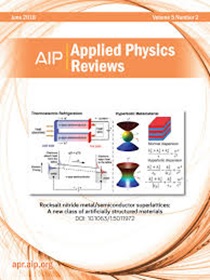揭示Mn掺杂对Cs4PbBr6晶体磁性和光电性能的影响
IF 11.6
1区 物理与天体物理
Q1 PHYSICS, APPLIED
引用次数: 0
摘要
金属卤化物钙钛矿以其优异的光电性能和多样的晶体结构引起了人们的极大关注。通过掺杂引入过渡元素作为一种有效的策略来调节其物理和化学性质。这种方法已被证明在赋予铁磁半导体特性方面是有效的,这对于自旋发光器件和半导体自旋电子学的应用是必不可少的。在这里,我们合成了Cs4PbBr6和Mn掺杂Cs4PbBr6 (Mn:Cs4PbBr6)钙钛矿单晶。磁化测量表明,Mn:Cs4PbBr6在30k时表现出铁磁性。互补密度泛函理论计算表明,观测到的磁性是由掺杂锰在带隙中引入的单自旋能态引起的。此外,我们在室温下观察到mn掺杂样品的负光电导率(NPC)效应。这种NPC现象归因于Mn:Cs4PbBr6晶体表面氧分子的吸附和解吸。我们的发现为未来高选择性气体传感器的发展奠定了基础。本文章由计算机程序翻译,如有差异,请以英文原文为准。
Unveiling the effects of Mn doping on magnetic and photoelectric properties of Cs4PbBr6 crystals
Metal halide perovskites have attracted extraordinary attention due to their excellent photoelectric properties and diverse crystal structures. The introduction of transition elements through doping serves as a potent strategy to modulate their physical and chemical properties. This approach has proven effective in imparting ferromagnetic semiconductor characteristics, which are essential for applications in spin light-emitting devices and semiconductor spintronics. Here, we synthesized Cs4PbBr6 and Mn-doped Cs4PbBr6 (Mn:Cs4PbBr6) perovskite single crystals. Magnetization measurements reveal that Mn:Cs4PbBr6 exhibits a ferromagnetic behavior at 30 K. Complementary density functional theory calculations suggest that the observed magnetism arises from the introduction of single-spin energy states by the doped Mn in the bandgap. Moreover, we observed a negative photoconductivity (NPC) effect at room temperature in the Mn-doped samples. This NPC phenomenon is attributed to the absorption and desorption of oxygen molecules on the surface of Mn:Cs4PbBr6 crystals. Our findings provide a foundation for the development of highly selective gas sensors in the future.
求助全文
通过发布文献求助,成功后即可免费获取论文全文。
去求助
来源期刊

Applied physics reviews
PHYSICS, APPLIED-
CiteScore
22.50
自引率
2.00%
发文量
113
审稿时长
2 months
期刊介绍:
Applied Physics Reviews (APR) is a journal featuring articles on critical topics in experimental or theoretical research in applied physics and applications of physics to other scientific and engineering branches. The publication includes two main types of articles:
Original Research: These articles report on high-quality, novel research studies that are of significant interest to the applied physics community.
Reviews: Review articles in APR can either be authoritative and comprehensive assessments of established areas of applied physics or short, timely reviews of recent advances in established fields or emerging areas of applied physics.
 求助内容:
求助内容: 应助结果提醒方式:
应助结果提醒方式:


